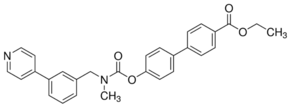All AbMole products are for research use only, cannot be used for human consumption.

For this product's availability, delivery time and price, please email [email protected] directly or click the "Inquiry Now" button below.
WWL113 is an inhibitor of mouse Carboxylesterase 3 (Ces3) and human CES1 (orthologue of mCes3), serine hydrolases involved in lipolysis in addition to their activities as liver detoxification enzymes. In a recent study, hCES1 activity was found to be increased two-fold in obese individuals and patients with type 2 diabetes compared to lean subjects, and is thought to generate surplus fatty acids that can deposit ectopically in tissues. WWL113 treatment resulted in major improvement of multiple features of metabolic syndrome and ameliorated obesity-diabetes in mice with lowered levels of nonesterified free fatty acids (NEFAs), triglycerides (TGs), total cholesterol and fasted glucose as well as enhanced glucose tolerance after three weeks of treatment. WWL113 inhibits Ces3 with an IC50 of 120 nM and also the closely related Ces1f with an IC50 of 100 nM. WWL113 inhibits mouse recombinant Ces1, Ces1c, and Abhd6 at 10 μM.
| Molecular Weight | 466.53 |
| Formula | C29H26N2O4 |
| CAS Number | 947669-86-5 |
| Solubility (25°C) | DMSO: 10 mg/mL |
| Storage |
Powder -20°C 3 years ; 4°C 2 years In solvent -80°C 6 months ; -20°C 1 month |
| Related Products |
|---|
| DSPE-PEG-FA
DSPE-PEG2K-FA is a PEG derivative containing folic acid. DSPE-PEG2K-FA has a targeting effect and can bind to folic acid receptors in cancer cells. DSPE-PEG2K-FA forms micelles/lipid bilayers and can be used in research on targeted drug delivery systems. |
| Lifastuzumab
Lifastuzumab is a humanized anti-NaPi2b IgG1 monoclonal antibody. |
| GPVI antagonist 1
GPVI antagonist 1 is a glycoprotein VI (GPVI) platelet receptor antagonist. GPVI antagonist 1 inhibits collagen-induced platelet aggregation with an IC50 of 25.3 μM. |
| MPSD TFA
MPSD TFA (MARCKS-ED TFA) is a 25-amino acid peptide based on the effector domain sequence of the intracellular membrane protein myristoylated alanine-rich C-kinase substrate (MARCKS). MPSD TFA can sense membrane curvature and recognize phosphatidylserine. MPSD TFA can be utilized as biological probe to study membrane shape and lipid composition. |
| 4-Nitro-2,1,3-benzoselenadiazole
4-Nitro-2,1,3-benzoselenadiazole is a biochemical material that can be used in scientific research. |
All AbMole products are for research use only, cannot be used for human consumption or veterinary use. We do not provide products or services to individuals. Please comply with the intended use and do not use AbMole products for any other purpose.


Products are for research use only. Not for human use. We do not sell to patients.
© Copyright 2010-2024 AbMole BioScience. All Rights Reserved.
